Tampa: A City of History, Culture, and Fun
Tampa is a city in Florida that offers a rich and diverse experience for visitors and residents alike. From its origins as a Native American settlement, to its role in the cigar industry and the Spanish-American War, to its modern attractions and amenities, Tampa has a lot to offer. In this article, we will explore some of the things that make Tampa unique and interesting.
Where Tampa Is Located
Tampa is located on the west coast of Florida, on the shores of Tampa Bay, near the Gulf of Mexico. It has a subtropical climate, with hot and humid summers and mild winters. The average annual temperature is 73.1 degrees. Tampa is the third largest city in Florida, after Miami and Jacksonville, and the 48th most populous city in the United States, with about 390,000 people.
What Tampa Is Known For
Tampa is known for its cultural diversity, as it has been influenced by various ethnic groups throughout its history. The most prominent are the Spanish, Cuban, Italian, and African American communities, who have contributed to the city’s cuisine, music, art, and festivals. One of the most famous examples of Tampa’s multicultural heritage is Ybor City, a historic district that was once the center of the cigar industry and the home of many immigrants from Cuba, Spain, and Italy. Today, Ybor City is a vibrant neighborhood that offers nightlife, entertainment, shopping, and dining options. It is also the site of the Columbia Restaurant, the oldest restaurant in Florida and the largest Spanish restaurant in the world.
Tampa is also known for its fun and adventurous side, as it boasts some of the best attractions and activities in the state. One of the most popular is Busch Gardens, a theme park that combines thrilling rides, exotic animals, and live shows. Another is the Florida Aquarium, one of the largest and most impressive aquariums in the country, that showcases thousands of marine creatures and habitats. For those who love nature and wildlife, Tampa offers many parks, trails, and preserves, such as the Hillsborough River State Park, the Lettuce Lake Park, and the Big Cat Rescue. For those who love sports and entertainment, Tampa hosts three professional sports teams: the Tampa Bay Buccaneers (NFL), the Tampa Bay Rays (MLB), and the Tampa Bay Lightning (NHL), as well as numerous concerts, festivals, and events throughout the year.
Conclusion
Tampa is a city that has something for everyone, whether you are looking for history, culture, or fun. It is a city that celebrates its past, embraces its present, and looks forward to its future. It is a city that invites you to discover its secrets and surprises.

